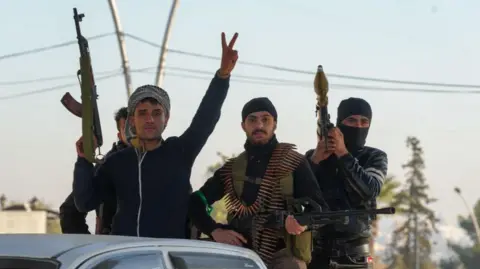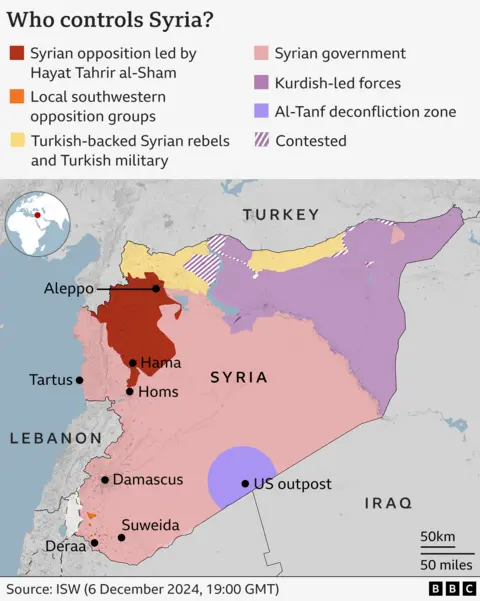Who are the rebels in Syria?

 getty images
getty imagesWith rebel forces now inside the Syrian capital Damascus, and reports that President Bashar al-Assad has fled the country, it appears less than a fortnight after anti-government forces began their lightning strikes. His rule has come to an end.
Islamist fighters captured the northern city of Aleppo in late November before moving south through Hama and Homs – areas previously under government control.
In southern Syria, close to the Jordanian border, local rebels have captured much of the Deraa region, the birthplace of the 2011 uprising against Assad.
In several instances, it was reported that Syrian forces either abandoned their positions or went over to the opposition.
The initial attack was led by the Islamist militant group Hayat Tahrir al-Sham (HTS) – which has a long and involved history in the Syrian conflict.
HTS has been designated as a terrorist organization by the United Nations, the US, Türkiye and other countries.
Who is Hayat Tahrir al-Sham?
 reuters
reutersHTS was founded under a different name, Jabhat al-NusraAs a direct affiliate of Al Qaeda in 2011.
Self-proclaimed leader of the Islamic State (IS) group, Abu Bakr al-BaghdadiWas also involved in its formation.
It was considered one of the most effective and deadly groups against President Assad.
But its jihadist ideology rather than revolutionary zeal appeared to be its driving force – and this was seen at odds with the main rebel coalition under the banner of Free Syria at the time.
And in 2016, the group’s leader, Abu Mohammed al-Joulani, publicly broke ties with al Qaeda, Disbanded Jabhat al-Nusra and established a new organizationwhich took the name Hayat Tahrir al-Sham when it merged with several other similar groups a year later.
For some time, HTS has established its power base in the northwestern province of Idlib, where it has de facto local governance, although its efforts toward legitimacy have been tarnished by alleged human rights abuses.
It has also been involved in some bitter infighting with other groups.
Its ambitions beyond Idlib became unclear.
Since breaking away from al Qaeda, its goals have been limited to trying to establish fundamentalist Islamic rule in Syria rather than a broader caliphate, as IS tried and failed.
It had so far shown no signs of attempting to reignite the Syrian conflict on a larger scale and renew its challenge to Assad’s rule over much of the country.

Why is there war in Syria?
In March 2011, inspired by rebellions in neighboring countries against repressive rulers, pro-democracy demonstrations broke out in the southern city of Deraa.
When the Syrian government used lethal force to crush dissent, protests broke out across the country demanding the president’s resignation.
Unrest spread and action intensified. Opposition supporters took up arms first to defend themselves and later to liberate their areas from security forces. Mr Assad vowed to crush “foreign-backed terrorism”.
Hundreds of rebel groups emerged, foreign powers began taking sides, and extremist jihadist organizations such as the Islamic State (IS) group and al-Qaeda became involved.
Violence quickly escalated and the country became involved in a full-scale civil war involving regional and world powers.
More than half a million people have been killed and 12 million have been forced to flee their homes, of whom about five million are refugees or asylum seekers abroad.
How did the rebel attack happen?
The four-year war in Syria felt as if it was effectively over.
President Bashar al-Assad’s rule remained essentially unopposed in the country’s major cities, while some other parts of Syria remained outside his direct control.
These include Kurdish-majority areas in the east, which have remained more or less under Syrian state control since the early years of the conflict.
In the south, where the revolution against Assad’s rule began in 2011, some unrest continued, although relatively less.
In the vast Syrian desert, factions of the group calling itself Islamic State still pose a security threat, especially during truffle hunting season when people head to the area to find the highly profitable delicacy.
And in the northwest, Idlib province is held by terrorist groups at the height of the war.
HTS, the main force in Idlib, has suddenly attacked Aleppo.
For several years, Idlib remained a battlefield as Syrian government forces tried to regain control.
But Armistice agreement brokered by Russia in 2020which has long been a key ally of Assad, and Türkiye, which has largely supported the rebels.
About four million people live there – most of them displaced from towns and cities that Assad’s forces won back from rebels in a brutal war.
Aleppo was one of the bloodiest battlefields and one of the rebels’ biggest defeats.
To achieve victory, President Assad could not rely alone on the country’s under-equipped and poorly motivated army, which soon became dangerously overextended and unable to hold positions against regular rebel attacks.
Instead, it became increasingly dependent on Russian airpower and Iranian military help on the ground – primarily through Tehran-sponsored militias.
Hezbollah was also included in these.
There is no doubt that the recent blow to Hezbollah Israeli attack in LebanonAdditionally, Israeli attacks on Iranian military commanders in Syria may have played a significant role in the decision by jihadist and rebel groups in Idlib to take a sudden, unexpected move on Aleppo.
Over the past few months, Israel has stepped up its attacks on Iran-linked groups as well as their supply lines, causing serious damage to the networks that have kept these militias, including Hezbollah, active in Syria.
Without them, President Assad’s forces are exposed.
Additional reporting by Maia Davis.






